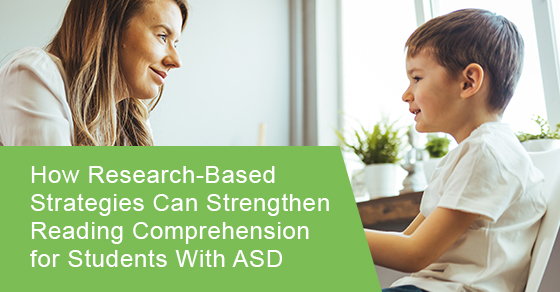Autism spectrum disorder (ASD) is a neurodevelopmental condition that affects an individual’s communication, social interaction, and behaviour. Reading comprehension is one of the most challenging aspects of learning for students on the autism spectrum. Research demonstrates that these individuals also have difficulty decoding words and reading with speed, accuracy, and expression.
Why do students with ASD struggle with reading comprehension?
People with ASD and learning disabilities may experience a number of challenges that can lead to the need for reading remediation.
Theory of Mind Deficits
Theory of Mind (ToM) deficits are difficulties in understanding and predicting the mental states of oneself and others, and they can have a significant impact on reading comprehension for students with ASD. ToM deficits may make it challenging for students with ASD to understand and interpret the thoughts and emotions of characters in a story. They may struggle to identify the motivations and intentions of the characters, which can make it difficult for them to follow the plot and predict what may happen next. Additionally, students with ASD may have trouble understanding the meaning of figurative language, such as metaphors and idioms, which can further impede their reading comprehension skills.
ToM deficits can also affect a student’s ability to make connections between the text and their own experiences or prior knowledge. These students may have difficulty with perspective-taking, which can hinder their ability to understand how different characters may perceive and interpret events. This can make it challenging for them to draw conclusions based on the information in the text. Students with ASD may also have problems identifying and understanding social cues, which can reduce their ability to comprehend the social interactions among characters in a story. These difficulties can result in a lack of engagement with the text and a limited ability to relate to the characters and themes presented.
Weak Central Coherence
Weak central coherence is a cognitive processing style that affects individuals with ASD. It refers to the tendency to focus on details rather than the whole picture. This can impact reading comprehension for students with ASD in several ways. They may struggle to understand the overall meaning of a text because of their focus on individual words or phrases rather than their context and connections. This can lead to difficulty in learning the main idea or themes of a text and may also affect their ability to make inferences and predictions.
In addition, weak central coherence may impede a student’s ability to understand figurative language such as idioms, metaphors, and similes. These expressions often rely on an understanding of the context and broader meaning of a text, which can be difficult for students with ASD who struggle with seeing the bigger picture. This can make it hard to fully engage with and appreciate literature, which is an important aspect of literacy development. It is therefore important for educators and support staff to be aware of the impact of weak central coherence on reading comprehension and to provide appropriate accommodations and strategies to support students with ASD in this area.
The Inability to Form Schemas
Schemas are shortcuts—mental frameworks that help individuals organize and make sense of new information based on prior knowledge and experience. This can affect their reading comprehension in several ways. For example, without an existing schema, they may struggle to connect new information to what they already know and understand, which can lead to confusion, frustration, and difficulty with recalling and applying what they have learned. Students with ASD may have difficulty identifying the main idea of a text or extracting the most important information from it. They might be unable to recognize the organizational structure of a text or may not have the prior knowledge to make predictions or draw conclusions about its content.
Lack of Background Knowledge
Students with ASD may lack background knowledge because of their tendency to have restricted interests and repetitive behaviors. They may become hyper focused on a specific topic or activity, which limits their exposure to a variety of experiences and information. Additionally, they may struggle with social communication and interactions, which can make it difficult for them to engage in the give-and-take of conversation and gather information from others. As a result, they can miss out on important experiences and information that could build their background knowledge.
That lack of background knowledge can have a significant impact on reading comprehension for students with autism. Without prior knowledge of a topic or concept, they may have trouble understanding the context and meaning of what they are reading. They may be unable to make connections between new information and what they already know, which can make it difficult for them to remember and apply that new information. This can lead to frustration and disengagement, which can further limit their opportunities to build background knowledge and improve their reading comprehension skills. Therefore, it is important to support students with autism in building their background knowledge through a variety of experiences and interventions.
Language and Communication Difficulties
One of the primary reasons why students with ASD have problems with reading comprehension is language and communication difficulties. Children on the autism spectrum may have difficulty with understanding and using language, which makes it difficult for them to comprehend what they read. For example, they may have difficulties with syntax, which affects their ability to understand sentence structure and the relationships between words in a sentence. Additionally, these students may take words literally, which can lead to confusion and misinterpretation. This lack of understanding can cause students to lose the context of the story or text they are reading.
Problems with Social Cues
Individuals on the autism spectrum often have difficulty interpreting social cues and understanding other people’s emotions. These challenges can impact their ability to comprehend the underlying meaning of a story or text. For example, they may have difficulty understanding the nuances of character relationships, social interactions, and nonverbal communication.
Sensory Processing Differences
Sensory processing issues are common in individuals on the autism spectrum. These differences can cause them to have difficulties with visual, auditory, and tactile processing. For example, they may find it hard to filter out background noises, bright lights, or smells, making it difficult to concentrate on reading. They may also struggle with tracking and following the text on a page, making it challenging to comprehend the content.
Restricted Interests
Individuals on the autism spectrum often have restricted interests or intense interests in specific subjects. This can make it challenging to engage them in reading materials that do not command their attention. For example, a student with a keen interest in cars may find it difficult to engage with a story about gardening.
Executive Functioning Difficulties
Executive functioning refers to a set of cognitive processes that are responsible for planning, organization, and problem-solving. Individuals on the autism spectrum often have difficulties with executive functioning, which can affect their reading comprehension. For example, they may struggle with organizing their thoughts and ideas, making it challenging to understand the relationships between different concepts in a text.
Reading Remediation Strategies to Improve Reading Comprehension for Students with ASD
Use Visual Aids
Visual aids such as pictures, diagrams, and graphic organizers can be effective tools for improving reading comprehension in students on the autism spectrum. Visual aids can help students understand the relationships between different concepts in a text and can provide context for the information being presented. These tools can help students understand the structure of a story, remember key details, and make connections between different parts of a text. For example, a graphic organizer could be used to help a student identify the main characters in a story, their relationships, and the sequence of events.
Simplify Language
Using simpler language can help students with ASD understand what they are reading. Teachers and parents can break down complex sentences and use simpler vocabulary to help students understand the meaning of the text.
Use Assistive Technology
Assistive technology such as text-to-speech software and audiobooks can be effective tools for improving reading comprehension for people with ASD. These tools can help students with decoding and fluency, which can make it easier for them to understand the content.
Explicit Instruction
Provide explicit instruction on how to create schemas and use them to facilitate reading comprehension. This can involve breaking down complex information into smaller parts, providing visual aids, and incorporating real-world examples that students can relate to and build upon.
Provide Context
Introducing context for the text can help every student improve their understanding of what they are reading. Offer background information on the topic before introducing the text.
Active Reading Strategies
Active reading strategies involve engaging with the text in a deliberate and intentional way. This can include activities such as predicting what will happen next, asking questions about the text, and summarizing key ideas. These strategies can help students to stay focused on the text, identify important information, and monitor their understanding. For example, a student could be taught to stop periodically while reading and summarize what they have just read in their own words.
Social Stories
Social stories are a strategy originally developed to help students with ASD understand social situations, but they can also be used to improve reading comprehension. Social stories are short narratives that describe a social situation or concept in a clear and concise way, often with the help of visual supports. Social stories are simple, short, and have defined criteria. They can be used to teach students about literary devices such as foreshadowing, point of view, and character development. By breaking down complex ideas into smaller, more manageable pieces, social stories can help students to understand and remember key concepts.
Reading is necessary for many aspects of learning in school, and initial difficulties can increase over time and impede a student’s ability to access the curriculum in other subjects. Students with reading disabilities often underachieve academically. When a student expresses frustration or difficulty with reading, or avoids the task, it is often a sign of a deficit that requires intervention. When students have difficulty learning to read, it can affect their confidence in their academic abilities and self-esteem, and lead to significant mental health concerns. When a student does not develop a strong foundation in word reading, it can set them up for further academic struggles. Reading is not natural, it is a skill that must be taught, and a reading disability has nothing to do with intelligence.
At Evoke, our reading remediation program teaches reading comprehension strategies based on the science of reading. Our reading remediation program can make significant improvements through direct instruction and training to correct a student’s deficits and undo inefficient word recognition habits. Using proven instructional principles, Evoke’s intervention approaches directly address word-level reading difficulties, train the skills that promote orthographic mapping (the process students use to become fluent readers), and ensure that the student’s learning transfers to the general application of skills. Student progress is measured using standardized assessments administered by a professional speech-language pathologist to determine the success of the interventions.
Let us help you or your student become a stronger, more confident reader.



